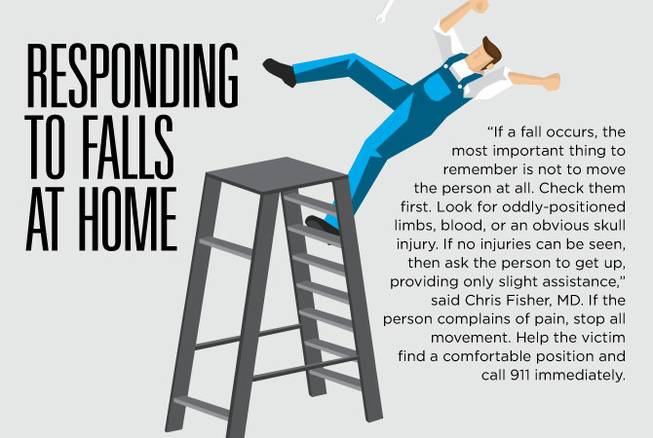
Sunday, May 22, 2016 | 2 a.m.
Traumatic injuries often occur at home and can happen to anyone. Falls, burns, cuts and many other accidents are bound to happen. Knowing what to do can prevent further injury and bring peace of mind. “The defining characteristic of a traumatic injury is the potential for loss of function, limb and/or life,” said Chris Fisher, MD, Sunrise Hospital Trauma Medical Director. For any injury that happens at home, especially ones that may be traumatic, a proper and calm response is critical.
Falls
Falls occur every day and in many different forms. Older adults or people with physical impairments may fall while simply attempting to stand. Falls can also occur on stairs, slick surfaces of even out of open windows. “If a fall occurs, the most important thing to remember is not to move the person at all. Check them first. Look for oddly-positioned limbs, blood, or an obvious skull injury. If no injuries can be seen, then ask the person to get up, providing only slight assistance,” Fisher says. He adds that if the person complains of pain to stop all movement. Help the fall victim find a comfortable position and call 911 immediately.
Wounds
To control bleeding, apply steady and direct pressure to the wound using a clean cloth. “If the blood soaks through the cloth or towel, do not remove it, just put more cloths or towels on top and continue to place pressure on the wound,” Fisher said. The bleeding should stop, or slow considerably, within 10 minutes. If the wound bleeds heavily or is deep, call an ambulance or go to the emergency room.
Burns
Immediately after a burn, rinse the skin with cold water for at least 5 minutes. This helps lessen the pain and stops the heat from penetrating deeper. Do not apply ice to the burn because doing so can cause further tissue damage. If the burn blisters, leave the blister intact and protect the area from dirt and heat. Wash the burn gently with mild soap and water, especially if the blister has burst, and do not apply butter or grease, as this can cause infection. If the skin appears white or charred, or it is noticeably falling away, call 911 immediately.
Use the ABCs at home
“ABC” stands for airway, breathing and circulation. These are the three most important components for assessing any injury before seeking or administering further medical treatment. Always be sure the person’s airway is clear, he or she is breathing regularly and his or her heart is pumping/blood is circulating — in that order.
• Airway: Remove any obstruction from the face/head and then gently tilt the head and lift the chin to promote an open airway.
• Breathing: Look, listen and feel for a steady breath.
• Circulation: Check the pulse, either at the wrist or neck, and be sure the heart is beating regularly. (Fisher advises checking the artery in the neck first — it may be easier to find.)
If any of the ABCs aren’t functioning properly, call an ambulance immediately. If the ABCs are fine, then assess the person’s consciousness and look for any sources of bleeding or obvious injury.
Sometimes follow-up is still necessary
After the ABCs, checking for consciousness and treating a bleeding or obvious injury are the best actions to take following an accident at home. However, if after performing these tasks, you still have a feeling that something still isn’t right, you may want to seek medical attention anyway. “One of the most common things I hear people say when they bring a loved one to the hospital is that ‘he or she just wasn’t acting right.’ There is often a feeling you can’t put your finger on, but if something just doesn’t feel right, listen to that voice,” Fisher said.
If you do seek medical attention, getting it as soon as possible helps improve the treatment odds. “We have a time window that is our best opportunity to get a patient to the hospital and stabilized called the golden hour of trauma,” Fisher said. “If a patient is transported and treated within the first hour from the initial injury, the risk of losing limb or life is decreased significantly.”
What to keep at home for treating injuries
“The most important thing is access to clean water. It is not just for drinking, but for cleaning wounds to see how bad they are and removing debris before dressing the wound,” Fisher said. A well-stocked First Aid kit also is important. It should include different sizes of bandages, gauze, antibacterial ointment, antiseptic wipes, a breathing barrier and latex gloves. Keeping clean towels on hand is helpful should you need them for a heavily bleeding wound.
What about kids?
Children are generally more vulnerable to getting hurt at home and are susceptible to common, household injuries, in addition to drowning, choking/suffocation and falling objects (such as televisions, cabinets and objects mounted to a wall).

Join the Discussion:
Check this out for a full explanation of our conversion to the LiveFyre commenting system and instructions on how to sign up for an account.
Full comments policy